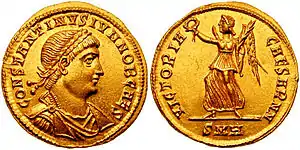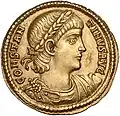| Constantine II | |||||||||
|---|---|---|---|---|---|---|---|---|---|
 Statue of Caesar Constantine II on top of the Cordonata (the monumental staircase climbing up to Piazza del Campidoglio), in Rome | |||||||||
| Roman emperor | |||||||||
| Augustus | 9 September 337 – 340 (Gaul, Hispania, and Britain) | ||||||||
| Predecessor | Constantine I | ||||||||
| Successor | Constantius II and Constans | ||||||||
| Co-emperors | Constantius II (East) Constans (Italy and Africa) | ||||||||
| Caesar | 1 March 317 – 9 September 337 | ||||||||
| Born | 316 Arelate, Viennensis | ||||||||
| Died | 340 (aged 24) Aquileia, Italy | ||||||||
| |||||||||
| Dynasty | Constantinian | ||||||||
| Father | Constantine the Great | ||||||||
| Mother | Fausta | ||||||||
| Religion | Arian Christianity | ||||||||
Constantine II (Latin: Flavius Claudius Constantinus; 316 – 340) was Roman emperor from 337 to 340. Son of Constantine the Great and co-emperor alongside his brothers, his attempt to exert his perceived rights of primogeniture led to his death in a failed invasion of Italy in 340.
Career
The eldest son of Constantine the Great and Fausta,[lower-alpha 1] Constantine II was born in Arles in 316 and raised as a Christian.[3]
Caesar
On 1 March 317, he was made caesar.[3] In 323, at the age of seven, he took part in his father's campaign against the Sarmatians.[3] At age ten, he became commander of Gaul, following the death of his half-brother Crispus. An inscription dating to 330 records the title of Alamannicus, so it appears that his generals won a victory over the Alamanni.[3] His military career continued when Constantine I made him field commander during the 332 winter campaign against the Goths. The military operation was successful and decisive, with 100,000 Goths reportedly slain and the surrender of the ruler Ariaric.[4][3] He was married prior to 336, although his wife’s identity remains unknown.[5]
Augustus
Following the death of his father in 337, Constantine II became emperor jointly with his brothers Constantius II and Constans.[6] While Constantine I had intended for his sons to rule together with their cousins Dalmatius and Hannibalianus, soon after his death the army slaughtered almost all of their male relatives, including Dalmatius and Hannibalianus.[7] Burgess observed from numismatic evidence that Constantine II and his brothers “not only seem not to have fully accepted the legitimacy of Dalmatius and viewed him as an interloper, but also appear to have communicated with one another on this point and agreed on a common response.”[8]
He was soon involved in the struggle between factions rupturing the unity of the Christian Church.[3] The Western portion of the empire, under the influence of the Popes in Rome, favoured Nicene Christianity over Arianism, and through their intercession they convinced Constantine to free Athanasius, allowing him to return to Alexandria.[3][9] This action aggravated Constantius II, who was a committed supporter of Arianism.[10]
The three brothers were not named as Augusti until 9 September 337,[1] when they gathered together in Pannonia[3] and divided the Roman territories among themselves. Constantine received Gaul, Britannia and Hispania.[11][12]
In what seemed to be an attempt to distance themselves from the massacre,[13] the three brothers proceeded to print coins of Theodora, whom their murdered relatives had been descended from.[7] The evidence indicates that Constantine II was the one responsible for designing and producing the coinage at the start, as well as convincing his brothers to do the same.[14] Woods considered it to suggest that he was more sympathetic to Theodora’s memory than his brothers,[15] possibly because his wife may have been a granddaughter of Theodora.[5]
It appears that Constantine was left unsatisfied with the results of their meeting, as he soon complained that he had not received the amount of territory that was his due as the eldest son.[16][17] Annoyed that Constans had received Thrace and Macedonia after the death of Dalmatius, Constantine demanded that Constans hand over the African provinces, to which he agreed in order to maintain a fragile peace.[17][18] Soon, however, they began quarreling over which parts of the African provinces belonged to Carthage, and thus Constantine, and which belonged to Italy, and therefore Constans.[19] Even after campaigning against the Alamanni in 338, he continued to maintain his position.[9][20] The Codex Theodosianus recorded Constantine’s legislative intervention in Constans’ territory through issuing an edict to the proconsul of Africa in 339.[9][20]
In 340 Constantine marched into Italy at the head of his troops to claim territory from Constans.[9][3] Constans, at that time in Naissus,[9] detached and sent a select and disciplined body of his Illyrian troops, stating that he would follow them in person with the remainder of his forces.[16] Constantine was engaged in military operations[6] and was killed by Constans's generals in an ambush outside Aquileia.[9][21] Constans then took control of his deceased brother's realm. After his death, Constantine was subjected to damnatio memoriae,[9] which his other brother Constantius II also followed.[20]
Family tree
| |||||||||||||||||||||||||||||||||||||||||||||||||||||||||||||||||||||||||||||||||||||||||||||||||||||||||||||||||||||||||||||||||||||||||||||||||||||||||||||||||||||||||||||||||||||||||||||||||||||||||||||||||||||||||||||||||||||||||||||||||||||||||||||||||||||||||||||||||||||||||||||||||||||||||||||||||||||||||||||||||||||||||||||||||||||||||||||||||||||||||||||||||||||||||||||||||||||||||||||||||||||||||||||||||||||||||||||||||||||||||||||||||||||||||||||||||||||||||||||||||||||||||||||||||||||||||||||||||||||||||||||||||||||||||||||||||||||||||||||||||||||||||||||||||||||||||||||||||||||||||||||||||||||||||||||||||||||||||||||||||||||||||||||||||||||||||||||||||||||||||||||||||||||||||||||||||||||||||||||||||||||||||||||||||||||||||||||||||||||||||||||||||||||||||||||||||||||||||||||||||||||||||||||||||||||||||||||||||||||||||||||||||||||||||||||||||||||||||||||||||||||||||||||||||||||||||||||||||||||||||||||||||||||||||||||||||||||||||||||||||||||||||||||||||||||||||||||||||||||||
| Family of Constantine II (emperor) | |||||||||||||||||||||||||||||||||||||||||||||||||||||||||||||||||||||||||||||||||||||||||||||||||||||||||||||||||||||||||||||||||||||||||||||||||||||||||||||||||||||||||||||||||||||||||||||||||||||||||||||||||||||||||||||||||||||||||||||||||||||||||||||||||||||||||||||||||||||||||||||||||||||||||||||||||||||||||||||||||||||||||||||||||||||||||||||||||||||||||||||||||||||||||||||||||||||||||||||||||||||||||||||||||||||||||||||||||||||||||||||||||||||||||||||||||||||||||||||||||||||||||||||||||||||||||||||||||||||||||||||||||||||||||||||||||||||||||||||||||||||||||||||||||||||||||||||||||||||||||||||||||||||||||||||||||||||||||||||||||||||||||||||||||||||||||||||||||||||||||||||||||||||||||||||||||||||||||||||||
|---|---|---|---|---|---|---|---|---|---|---|---|---|---|---|---|---|---|---|---|---|---|---|---|---|---|---|---|---|---|---|---|---|---|---|---|---|---|---|---|---|---|---|---|---|---|---|---|---|---|---|---|---|---|---|---|---|---|---|---|---|---|---|---|---|---|---|---|---|---|---|---|---|---|---|---|---|---|---|---|---|---|---|---|---|---|---|---|---|---|---|---|---|---|---|---|---|---|---|---|---|---|---|---|---|---|---|---|---|---|---|---|---|---|---|---|---|---|---|---|---|---|---|---|---|---|---|---|---|---|---|---|---|---|---|---|---|---|---|---|---|---|---|---|---|---|---|---|---|---|---|---|---|---|---|---|---|---|---|---|---|---|---|---|---|---|---|---|---|---|---|---|---|---|---|---|---|---|---|---|---|---|---|---|---|---|---|---|---|---|---|---|---|---|---|---|---|---|---|---|---|---|---|---|---|---|---|---|---|---|---|---|---|---|---|---|---|---|---|---|---|---|---|---|---|---|---|---|---|---|---|---|---|---|---|---|---|---|---|---|---|---|---|---|---|---|---|---|---|---|---|---|---|---|---|---|---|---|---|---|---|---|---|---|---|---|---|---|---|---|---|---|---|---|---|---|---|---|---|---|---|---|---|---|---|---|---|---|---|---|---|---|---|---|---|---|---|---|---|---|---|---|---|---|---|---|---|---|---|---|---|---|---|---|---|---|---|---|---|---|---|---|---|---|---|---|---|---|---|---|---|---|---|---|---|---|---|---|---|---|---|---|---|---|---|---|---|---|---|---|---|---|---|---|---|---|---|---|---|---|---|---|---|---|---|---|---|---|---|---|---|---|---|---|---|---|---|---|---|---|---|---|---|---|---|---|---|---|---|---|---|---|---|---|---|---|---|---|---|---|---|---|---|---|---|---|---|---|---|---|---|---|---|---|---|---|---|---|---|---|---|---|---|---|---|---|---|---|---|---|---|---|---|---|---|---|---|---|---|---|---|---|---|---|---|---|---|---|---|---|---|---|---|---|---|---|---|---|---|---|---|---|---|---|---|---|---|---|---|---|---|---|---|---|---|---|---|---|---|---|---|---|---|---|---|---|---|---|---|---|---|---|---|---|---|---|---|---|---|---|---|---|---|---|---|---|---|---|---|---|---|---|---|---|---|---|---|---|---|---|---|---|---|---|---|---|---|---|---|---|---|---|---|---|---|---|---|---|---|---|---|---|---|---|---|---|---|---|---|---|---|---|---|---|---|---|---|---|---|---|---|---|---|---|---|---|---|---|---|---|---|---|---|---|---|---|---|---|---|---|---|---|---|---|---|---|---|---|---|---|---|---|---|---|---|---|---|---|---|---|---|---|---|---|---|---|---|---|---|---|---|---|---|---|---|---|---|---|---|---|---|---|---|---|---|---|---|---|---|---|---|---|---|---|---|---|---|---|---|---|---|---|---|---|---|---|---|---|---|---|---|---|---|---|---|---|---|---|---|---|---|---|---|---|---|---|---|---|---|---|---|---|---|---|---|---|---|---|---|---|---|---|---|---|---|---|---|---|---|---|---|---|---|---|---|---|---|---|---|---|---|---|---|---|---|---|---|---|---|---|---|---|---|---|---|---|---|---|---|---|
|
Emperors are shown with a rounded-corner border with their dates as Augusti, names with a thicker border appear in both sections 1: Constantine's parents and half-siblings
| |||||||||||||||||||||||||||||||||||||||||||||||||||||||||||||||||||||||||||||||||||||||||||||||||||||||||||||||||||||||||||||||||||||||||||||||||||||||||||||||||||||||||||||||||||||||||||||||||||||||||||||||||||||||||||||||||||||||||||||||||||||||||||||||||||||||||||||||||||||||||||||||||||||||||||||||||||||||||||||||||||||||||||||||||||||||||||||||||||||||||||||||||||||||||||||||||||||||||||||||||||||||||||||||||||||||||||||||||||||||||||||||||||||||||||||||||||||||||||||||||||||||||||||||||||||||||||||||||||||||||||||||||||||||||||||||||||||||||||||||||||||||||||||||||||||||||||||||||||||||||||||||||||||||||||||||||||||||||||||||||||||||||||||||||||||||||||||||||||||||||||||||||||||||||||||||||||||||||||||||
Gallery
.png.webp) Coin of Constantine II as caesar, marked: d·n· fl· cl· constantinus nob· c· ("Our Lord Flavius Claudius Constantine, Noblest Caesar")
Coin of Constantine II as caesar, marked: d·n· fl· cl· constantinus nob· c· ("Our Lord Flavius Claudius Constantine, Noblest Caesar")
 Aureus of Constantine II as caesar, marked: constantinus iun· nob· c· ("Constantine Junior, Noblest Caesar") on the obverse and virtus caesar n· ("the Virtue of Our Caesar") on the reverse
Aureus of Constantine II as caesar, marked: constantinus iun· nob· c· ("Constantine Junior, Noblest Caesar") on the obverse and virtus caesar n· ("the Virtue of Our Caesar") on the reverse Coin of Constantine II as augustus.
Coin of Constantine II as augustus. Division of the Roman Empire among the Caesars appointed by Constantine I: from west to east, the territories of Constantine II, Constans, Dalmatius and Constantius II.
Division of the Roman Empire among the Caesars appointed by Constantine I: from west to east, the territories of Constantine II, Constans, Dalmatius and Constantius II.
References
- 1 2 3 Jones, Martindale & Morris, p. 223.
- ↑ Barnes 1973, p. 36-37.
- 1 2 3 4 5 6 7 8 9 DiMaio Jr, Michael; Frakes, Robert (2 May 1998). "Constantine II (337–340 A.D.)". De Imperatoribus Romanis - Online Encyclopedia of Roman Emperors.
- ↑ Odahl, Charles (2010). Constantine and the Christian Empire (2 ed.). London: Routledge. p. 253. ISBN 978-0-203-85028-2. OCLC 650534102.
- 1 2 Woods 2011, p. 195.
- 1 2 Eutropius, 10:9
- 1 2 Hunt 1998, p. 3.
- ↑ Burgess 2008, p. 21-22.
- 1 2 3 4 5 6 7 Hunt 1998, p. 5.
- ↑ Howard, Nathan D. (26 October 2012), "Constantine II", The Encyclopedia of Ancient History, Hoboken, NJ: John Wiley & Sons, Inc., doi:10.1002/9781444338386.wbeah05050, ISBN 9781444338386
- ↑ "Constantine II – Roman Emperor". Encyclopedia Britannica. 2021.
- ↑ Hunt 1998, p. 4.
- ↑ Woods 2011, p. 194-195.
- ↑ Burgess 2008, p. 23.
- ↑ Woods 2011, p. 194.
- 1 2 DiMaio 1988, p. 240.
- 1 2 Gibbon, Ch. 18
- ↑ Victor, 41:21
- ↑ Zosimus, 2:41–42
- 1 2 3 Crawford 2016.
- ↑ DiMaio 1988, p. 241.
Sources
Primary sources
- Zosimus, Historia Nova, Book 2 Historia Nova
- Aurelius Victor, Epitome de Caesaribus
- Eutropius, Breviarium ab urbe condita
Secondary sources
- Barnes, T. D. (7 December 1973). "Lactantius and Constantine". The Journal of Roman Studies. 63: 29–46. doi:10.2307/299163. JSTOR 299163. S2CID 163051414.
- Burgess, R.W. (2008). "THE SUMMER OF BLOOD: The "Great Massacre" of 337 and the Promotion of the Sons of Constantine". Dumbarton Oaks Papers. 62: 5–51. JSTOR 20788042.
- Crawford, Peter (2016). Constantius II: Usurpers, Eunuchs, and the Antichrist. Pen & Sword. ISBN 978-1-78340-055-3.
- DiMaio, Michael, and Robert Frakes, "Constantine II (337–340 A.D.)", D.I.R.
- DiMaio, Michael (1988). "SMOKE IN THE WIND : ZONARAS' USE OF PHILOSTORGIUS, ZOSIMUS, JOHN OF ANTIOCH, AND JOHN OF RHODES IN HIS NARRATIVE ON THE NEO-FLAVIAN EMPERORS". Byzantion. 58 (1): 230–255. JSTOR 44171050.
- Hunt, David (1998), "The successors of Constantine", The Cambridge Ancient History, vol. XIII: the Late Empire AD 337–425, Cambridge: University Press
- Jones, A.H.M.; J.R. Martindale & J. Morris (1971). The Prosopography of the Later Roman Empire Volume 1: A.D. 260–395. Cambridge University Press. ISBN 0-521-07233-6.
- Woods, David (2011). "Numismatic Evidence and the Succession to Constantine I". The Numismatic Chronicle. 171: 187–196. JSTOR 42667233.
- Gibbon, Edward. Decline & Fall of the Roman Empire (1888)
- Lewis, William (2020), "Constantine II and His Brothers: The Civil War of AD 340", in Nicholas Baker-Brian and Shaun Tougher (eds.), The Sons of Constantine, AD 337–361: In the Shadows of Constantine and Julian. Palgrave Macmillan. Cham. ISBN 978-3-030-39897-2.
External links
 Media related to Flavius Claudius Constantinus at Wikimedia Commons
Media related to Flavius Claudius Constantinus at Wikimedia Commons